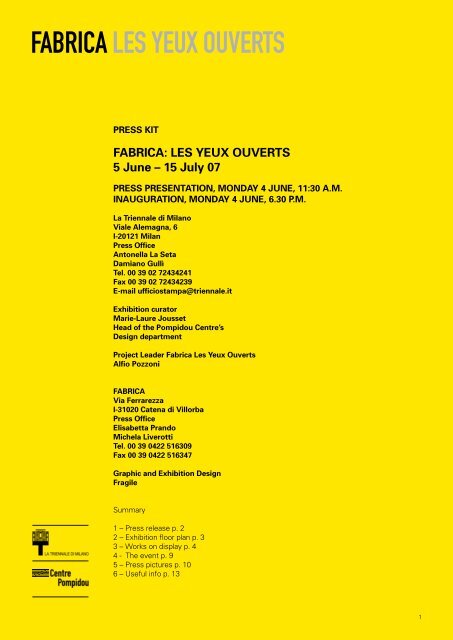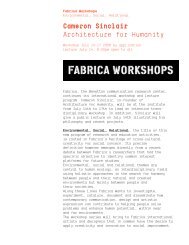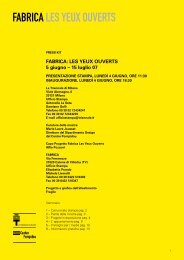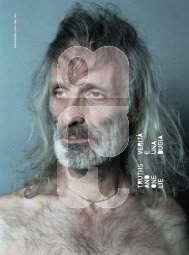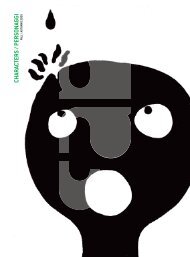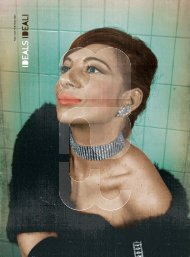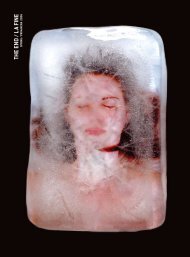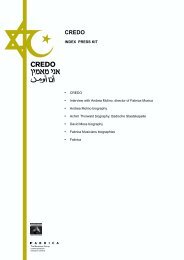FABRICA LES YEUX OUVERTS
FABRICA LES YEUX OUVERTS
FABRICA LES YEUX OUVERTS
You also want an ePaper? Increase the reach of your titles
YUMPU automatically turns print PDFs into web optimized ePapers that Google loves.
<strong>FABRICA</strong> <strong>LES</strong> <strong>YEUX</strong> <strong>OUVERTS</strong><br />
PRESS KIT<br />
<strong>FABRICA</strong>: <strong>LES</strong> <strong>YEUX</strong> <strong>OUVERTS</strong><br />
5 June – 15 July 07<br />
PRESS PRESENTATION, MONDAY 4 JUNE, 11:30 A.M.<br />
INAUGURATION, MONDAY 4 JUNE, 6.30 P.M.<br />
La Triennale di Milano<br />
Viale Alemagna, 6<br />
I-20121 Milan<br />
Press Office<br />
Antonella La Seta<br />
Damiano Gullì<br />
Tel. 00 39 02 72434241<br />
Fax 00 39 02 72434239<br />
E-mail ufficiostampa@triennale.it<br />
Exhibition curator<br />
Marie-Laure Jousset<br />
Head of the Pompidou Centre’s<br />
Design department<br />
Project Leader Fabrica Les Yeux Ouverts<br />
Alfio Pozzoni<br />
<strong>FABRICA</strong><br />
Via Ferrarezza<br />
I-31020 Catena di Villorba<br />
Press Office<br />
Elisabetta Prando<br />
Michela Liverotti<br />
Tel. 00 39 0422 516309<br />
Fax 00 39 0422 516347<br />
Graphic and Exhibition Design<br />
Fragile<br />
Summary<br />
1 – Press release p. 2<br />
2 – Exhibition floor plan p. 3<br />
3 – Works on display p. 4<br />
4 - The event p. 9<br />
5 – Press pictures p. 10<br />
6 – Useful info p. 13
<strong>FABRICA</strong> <strong>LES</strong> <strong>YEUX</strong> <strong>OUVERTS</strong><br />
1. PRESS RELEASE<br />
5 June to 15 July 2007<br />
<strong>FABRICA</strong>: <strong>LES</strong> <strong>YEUX</strong> <strong>OUVERTS</strong><br />
AT THE MILAN TRIENNALE<br />
The Pompidou Centre exhibition comes to Italy<br />
Fabrica: les yeux ouverts, the exhibition which the Pompidou Centre mounted in Paris<br />
in October 2006, starts its journey as a travelling exhibition to debut in Italy at the Milan<br />
Triennale from 5 June to 15 July 2007.<br />
Being invited to the Milan Triennale – a major Italian design and architecture institution<br />
– is yet a further and very important accolade for Fabrica. Davide Rampello, chairman of<br />
the Milan Triennale, said, “We have always been very interested in the products of Italian<br />
manufacturers, the true driving forces behind Italian design, and in their communication<br />
strategies, especially in the skills of the Benetton Group which invented, not least<br />
through its work with Oliviero Toscani, a new form of advertising”.<br />
The exhibition is curated by Marie-Laure Jousset, the head of the Pompidou Centre’s<br />
design department. It has a new design for its Milan sojourn though the original<br />
inspiration is preserved: a summa of Fabrica’s many personalities as a place of<br />
exploration and innovation, the fruit of the industrial culture of Benetton Group.<br />
Fabrica presents its documentary (COLORS magazine and photo reports) and<br />
experimental (media art, interactive, video, visual communication) projects integrated<br />
with new stories and the premières of many new videos. There will also be two new<br />
interactive installations to encourage the public’s direct involvement. A new feature in<br />
Milan is the presentation of Fabrica Features, Fabrica’s satellites in Bologna, Lisbon,<br />
Hong Kong, Rotterdam and London. Points of sale of the design products bearing the<br />
same name, but also the nuclei of a network of cultural encounters and presentations<br />
integrated with the local artistic scene.<br />
Fabrica: les yeux ouverts will resume its travels in autumn 2007; it has accepted the<br />
Shanghai Cultural Development Foundation’s invitation to Bund 18, an exhibition space<br />
at one of the city’s most significant historical addresses.<br />
www.centrepompidou.fr<br />
www.fabrica.it/triennale
<strong>FABRICA</strong> <strong>LES</strong> <strong>YEUX</strong> <strong>OUVERTS</strong><br />
2. EXHIBITION FLOOR PLAN
<strong>FABRICA</strong> <strong>LES</strong> <strong>YEUX</strong> <strong>OUVERTS</strong><br />
3. WORKS ON DISPLAY<br />
FIRST SECTION – AN EYE ON THE WORLD<br />
This section presents a collaborative effort with Reporters Without Borders, COLORS<br />
Notebook, to give voice to those who are usually never heard. It is a collection of stories<br />
from people who live in the remotest areas of the world or in places where freedom<br />
of speech is under threat. This section also explores Fabrica’s characteristic openness<br />
to the world through a collection, entitled I SEE, of theme-based photo reports from<br />
six major areas of the world, and presents <strong>FABRICA</strong> FEATURES.<br />
- COLORS NOTEBOOK<br />
- I SEE<br />
- <strong>FABRICA</strong> FEATURES<br />
COLORS NOTEBOOK (2006-2007)<br />
COLORS Magazine’s editorial staff (Italy)<br />
Developed with Reporters Without Borders, COLORS Notebook was published in April<br />
2006. It was full of blank pages in order to give voice to those whose voice is never<br />
heard. Thirty thousand copies reached the farthest corners of the earth, offering Chinese<br />
prisoners, South African children, Canadian priests, astronauts, disabled persons, artists<br />
and ordinary people the chance to express themselves without filters or censure.<br />
Over 1,000 copies returned to Fabrica, bringing their messages with them. COLORS<br />
Notebook is a tribute to a free press and freedom of expression. It also highlights<br />
the importance of the human factor in any relationship. Launched in 1991, COLORS<br />
magazine is published in four languages and sold in more than 40 countries.<br />
I SEE (2006)<br />
Olivia Arthur (United Kingdom), Adam Huggins (Canada), Ashley Gilbertson (Australia),<br />
Leonie Purchas (United Kingdom), Lorenzo Vitturi (Italy), Philipp Ebeling (Germany).<br />
A physical and visual journey of exploration into the current trends of historical, cultural,<br />
artistic, social and economic development. “I see” also means “I observe” and “I<br />
understand”. Six photographers from Fabrica each chose a story to represent one of the<br />
world’s six main geographic areas: North America, South America, East, Far East, Africa<br />
and Europe.<br />
The Middle Distance<br />
Olivia Arthur (United Kingdom)<br />
Through the stories of young women living in Eurasian countries on the border between<br />
East and West, Olivia Arthur relates the social, cultural and religious pressures resulting<br />
from the encounter of different cultures and the ways in which the various societies<br />
react to change.
<strong>FABRICA</strong> <strong>LES</strong> <strong>YEUX</strong> <strong>OUVERTS</strong><br />
Death and Birth<br />
Ashley Gilbertson (Australia)<br />
After risking his life every day for four years as a war reporter in Iraq, Ashley Gilbertson<br />
depicts the life and death of the various communities living in Vienna. He shows<br />
the value of our existence by photographing life’s first cry and its dying breath.<br />
The Villamil Family - Divided Lives<br />
Leonie Purchas (United Kingdom)<br />
Leonie Purchas’s photo report explores the idea of the family and its role in society<br />
through a portrait gallery of a family divided, whose members live in Cuba and<br />
Los Angeles. Her work captures the things that stay the same even in different<br />
social environments.<br />
Oil Will Never End<br />
Lorenzo Vitturi (Italy)<br />
Lorenzo Vitturi addresses the energy problem, from studies of alternative, cleaner<br />
energy sources to the depletion of the planet’s resources. He focuses special attention<br />
on the exhaustion of the Caspian Sea oil fields.<br />
Under the Weather<br />
Philipp Ebeling (Germany)<br />
For his report on the extreme weather phenomena of the past decade, Philipp Ebeling<br />
focuses his lens on China and shows the other side of the coin of the country’s<br />
extraordinary urban growth and industrial expansion: desertification, draining of rivers,<br />
exceptional heat waves and the sharp contrasts in people’s daily lives.<br />
Lines of Food: Men and Fishing<br />
Adam Huggins (Canada) in co-operation with Terra Madre<br />
Terra Madre is a Slow Food forum which brings together representatives of communities<br />
across the five continents in order to develop a new idea of sustainable agriculture.<br />
Adam Huggins follows fishermen from three continents (Asia, America and Africa) during<br />
their work and daily life to record the various traditional fishing techniques and their<br />
relationship with the local way of life.<br />
<strong>FABRICA</strong> FEATURES (2001-2007)<br />
Sam Baron (France), Carine Damon (France), Cristina Dias (Portugal), Marta Teixeira<br />
(Portugal). With contributions from: Sophie Albert (France), Rita Botelho (Portugal),<br />
Caoceito (Portugal), Valentina Carretta (Italy), Aurore Dumas (France), Meric Kara<br />
(Turkey), Massimo Parolin (Italy), Annechien Van Litsenburg (Netherlands).<br />
Thanks to: Studioverrissimo, Bosa, Paola C., designforfuture.org, Hpf Cork, Olfaire,<br />
Lunardon, Tosca lab.<br />
Fabrica Features stores are meeting places focused on dialogue and interaction between<br />
artists/designers and the general public. Opened in five world cities (Bologna, Lisbon,<br />
Hong Kong, Rotterdam and London), Fabrica Features are a geographical embodiment<br />
of the Fabrica network and are meant as observatories of their host city’s artistic<br />
environments and urban lifestyles. This installation presents a “landscape” of objects:<br />
some were created by Fabrica through its work with the business world. Others<br />
were chosen because they belong to Fabrica’s creative universe or because they are<br />
representative of a nation’s cultural identity. The installation is accompanied by a number<br />
of screens showing the activities which take place in each Fabrica Features space that<br />
are transmitted and shared via a special blog and interspersed with daily contributions<br />
from artists.
<strong>FABRICA</strong> <strong>LES</strong> <strong>YEUX</strong> <strong>OUVERTS</strong><br />
SECOND SECTION – THE VISUAL COMMUNICATION<br />
This part illustrates Fabrica’s main line of work: visual communication. Graphics,<br />
photography and videos are the tools it places at the service of its partners, including<br />
many institutions and NGOs. The exhibition then presents two global communication<br />
campaigns: Violence (2003) for the World Health Organisation and Food for Life (2003)<br />
for the World Food Programme and a selection of self-portraits produced by Fabrica’s<br />
young artists.<br />
- VISUAL COMMUNICATION<br />
- VIOLENCE<br />
- FOOD FOR LIFE<br />
- SELFPORTRAITS<br />
VISUAL COMMUNICATION (1994-2007)<br />
Fabrica, various creators<br />
An image gallery of Fabrica pictures for non-profit organisations such as the World Health<br />
Organisation, Amnesty International, Reporters Without Borders, Lawyers’ Committee<br />
for Human Rights, Witness, the FAO (the UN’s Food and Agricultural Organisation) and<br />
the UNHCR (the United Nations High Commissioner for Refugees). Posters for cultural<br />
projects, books, musical events, and films co-produced by Fabrica (such as No Man’s<br />
Land, Oscar winner for Best Foreign Film); pictures and campaigns for Fabrica-organised<br />
exhibitions; posters for topical events (such as Visions of Hope regarding September<br />
11) or global issues (drugs, AIDS, diversity, soccer and religion). The Wanted Creativity<br />
collection of illustrations and personal projects.<br />
VIOLENCE (2003)<br />
Gabriele Riva (Italy)<br />
A communication campaign for WHO (the World Health Organisation) dealing with<br />
the most difficult kinds of violence to report and fight: marital violence, self-inflicted<br />
injuries, sexual violence, group violence, child abuse, ill-treatment of old people, child<br />
abandonment. Launched in May 2003, the campaign was publicised around the world<br />
and translated into many different languages to raise awareness about means of getting<br />
help and taking preventive measures.<br />
FOOD FOR LIFE (2003)<br />
James Mollison (United Kingdom)<br />
A United Colors of Benetton advertising campaign developed in co-operation with the<br />
UN’s World Food Programme. The pictures, taken in Afghanistan, Cambodia, Guinea<br />
and Sierra Leone, illustrate the correlation between malnutrition and social problems<br />
(education, jobs, peace, female emancipation). The distribution of food in schools<br />
was particularly effective in ensuring children could receive an education. Fabrica has<br />
produced United Colors of Benetton’s communication campaigns since 2000.<br />
SELFPORTRAITS (1995-2007)<br />
Fabrica, various creators<br />
A selection of self-portraits made by the young people at Fabrica. A way of showing<br />
Fabrica’s origins and its present reality through the eyes of those who have been part<br />
of the communication centre’s life.
<strong>FABRICA</strong> <strong>LES</strong> <strong>YEUX</strong> <strong>OUVERTS</strong><br />
THIRD SECTION – THE INTERACTIVE EXPERIENCE<br />
The third section presents video projects and the interactive experiments – both sensory<br />
and cognitive – developed by the teams at Fabrica.<br />
- GET IN TOUCH<br />
- FLIPBOOK!<br />
- EVIDENCE<br />
- WE ARE THE TIME. WE ARE THE FAMOUS<br />
- STOCK EXCHANGE OF VISIONS<br />
- FORWARD<br />
- SIENA (ITALY), GRANADA AND SOLENTINAME (NICARAGUA)<br />
GET IN TOUCH (2007)<br />
Stefano Bergonzini (Italy) in co-operation with Luca Bilotta (Italy)<br />
A sensory wall which uses graphic signs to connect the hands that touch it to create a<br />
visual reproduction of the network concept which underpins Fabrica’s vision of the world,<br />
in the sense of technological interactivity and an ideological dialogue among<br />
different cultures.<br />
FLIPBOOK! (2005-2007)<br />
Juan Ospina (Colombia), with contributions by Enrique R. Grullon (Dominican<br />
Republic), Maik Bluhm (Germany), Hans Raber (Austria)<br />
Grand Prize winner at the prestigious Japan Media Arts Festival, FLIPBOOK!<br />
(http://www.fabrica.it/flipbook/), an interactive animation project, enables anyone to<br />
draw an animated story, then upload it and share it online. The result is a community of<br />
thousands of short stories; some are simple and amusing while others are violent, painful<br />
or erotic. In a very short time, FLIPBOOK! has become a web phenomenon with over<br />
200,000 animations and 15 million visitors.<br />
EVIDENCE (1995)<br />
Godfrey Reggio (USA)<br />
Godfrey Reggio - visionary American director and the man behind Anima Mundi -<br />
observes children’s relationship with television in a short film; the soundtrack is by Philip<br />
Glass. Produced when Reggio was Fabrica’s director, Evidence has been shown at many<br />
film festivals, including Locarno in 1997.<br />
WE ARE THE TIME. WE ARE THE FAMOUS (2005)<br />
Andy Cameron (United Kingdom), Hans Raber (Austria), David McDougall (United<br />
Kingdom), Oriol Ferrer Mesía (Spain)<br />
An installation that brings visitors into the action. It explores two ways of being portrayed<br />
in a time span: the fixed photo image or a filmed sequence. Visitors interact in real time<br />
with two images of themselves: the first, in slow motion, confuses our perception of<br />
time, while the other fragments time into a succession of stills. On one wall, visitors<br />
must stand still to see their image, while on the other they have to keep moving to<br />
generate a sequence. The title is taken from J.L. Borges’s poem: “We are the time.<br />
We are the famous”.
<strong>FABRICA</strong> <strong>LES</strong> <strong>YEUX</strong> <strong>OUVERTS</strong><br />
STOCK EXCHANGE OF VISIONS (2006-2007)<br />
From an idea by Gregor Kuschmirz (Germany), with contributions by Alfio Pozzoni<br />
(Italy), Paolo Jannuzzi (Switzerland), Stefano Bergonzini (Italy), Giorgio Collodet (Italy)<br />
Drawing inspiration from stock exchanges’ scrolling ticker screens, Stock Exchange<br />
of Visions displays scientists’, sociologists’ and futurologists’ vision of the future as<br />
concerns culture, the environment, resources, the economy and society. By means<br />
of an under-floor control panel, visitors can choose the subject that interests them, thus<br />
generating a diagram with the topics of greatest concern to the public. Stock Exchange<br />
of Visions is also a website, www.stockexchangeofvisions.org, to create a global network<br />
of “visions” crucial to the future of humanity.<br />
FORWARD (2007)<br />
Sphere: Erik Ravelo (Cuba), Giorgio Collodet (Italy)<br />
Videos: Fernando Acquarone (Brazil), Valeria Giulianelli (Italy), Brad Hasse<br />
(United States), Alex Healey (United Kingdom), Diego Hurtado de Mendoza (Spain),<br />
Erik Ravelo (Cuba)<br />
Huge clear spheres through which we may glimpse the future. Using a special touch<br />
screen, visitors can select images, videos or documentaries about climatic change and<br />
eco-sustainability. Also, by placing one picture of nature over another, both of which<br />
move in a see-through effect, visitors create possible future scenarios.<br />
SIENA (ITALY), GRANADA AND SOLENTINAME (NICARAGUA) (2007)<br />
Cosimo Bizzarri (Italy), Giorgio Collodet (Italy), Valeria Giulianelli (Italy), Paolo<br />
Jannuzzi (Switzerland), Matthew Prins (United Kingdom), Erik Ravelo (Cuba), Andrés<br />
Reymondes (Argentina), Guillermo Rivero (Mexico), Ciro Zecca (Italy)<br />
Fabrica’s video-department grant holders explored the idea of sustainability and<br />
self-sustainable development in collaboration with a group of scientists, writers and<br />
architects, producing two videos which take a look at one of the most hotly-debated<br />
current topics. This exploration also led to a special issue of COLORS, devoted<br />
to the environment.
<strong>FABRICA</strong> <strong>LES</strong> <strong>YEUX</strong> <strong>OUVERTS</strong><br />
4. - THE EVENT<br />
Thursday 14 June<br />
Meeting Al Gore<br />
former future U.S. president, to reflect on the changes happening to the planet<br />
for the publication of COLORS Vörland, devoted to a tropical island off the coast of<br />
Scandinavia
<strong>FABRICA</strong> <strong>LES</strong> <strong>YEUX</strong> <strong>OUVERTS</strong><br />
5.– PRESS PICTURES<br />
1. PROJECTS IN THE EXHIBITION<br />
- COLORS NOTEBOOK (2006-2007)<br />
© Colors / Fabrica<br />
Credits:<br />
Images no. 01, 02: Eduardo Bertone, Nuria Gil<br />
Images no. 03, 04, 05, 06: Pamela Walls<br />
Image no. 07: Eria Solomon Nsubuga<br />
Image no. 08: Ling Ada<br />
Image no. 09: Steven K. Ainsworth<br />
Images no. 10, 11: Guadalupe de Aguero Servin, Ximena de A.<br />
Image no. 12: anonymous<br />
Images no. 13, 14, 15: Nuria Gil, Eduardo Bertone<br />
Images no. 16, 17: Juliana, Gertrude Stein<br />
Images no. 18, 19: Patricia Tourne<br />
Image no. 20: Irwin Cruz<br />
Images no. 29, 30: Mirella Brugnerotto<br />
Images no. 31, 32: Twiggy Li<br />
Images no. 33, 34: Natasja Maria Fourie<br />
Images no. 35, 36: Pascal Hachem<br />
Image no. 37: Covers<br />
Photo credits:<br />
Images no. 01-20 and 37: Sebastiano Scattolin / Fabrica<br />
Images no. 29-36: Alessandro Russotti<br />
- INTERACTIVE<br />
Flipbook! (2005-2007)<br />
© Juan Ospina / Fabrica<br />
Stock Exchange of Visions (2006-2007)<br />
© Gregor Kuschmirz / Fabrica<br />
We are the time. We are the famous 1, 2 (2005)<br />
© Andy Cameron, Hans Raber, David McDougall, Oriol Ferrer Mesía / Fabrica<br />
10
<strong>FABRICA</strong> <strong>LES</strong> <strong>YEUX</strong> <strong>OUVERTS</strong><br />
- PHOTOGRAPHY<br />
I SEE (2006)<br />
Death and Birth<br />
© Ashley Gilbertson / Fabrica<br />
Lines of Food: Men and Fishing<br />
© Adam Huggins / Fabrica<br />
Oil Will Never End<br />
© Lorenzo Vitturi / Fabrica<br />
The Middle Distance<br />
© Olivia Arthur / Fabrica<br />
The Villamil Family – Divided Lives<br />
© Leonie Purchas / Fabrica<br />
Under the Weather<br />
© Philipp Ebeling / Fabrica<br />
- VISUAL COMMUNICATION<br />
Food for Life (2003)<br />
© James Mollison / Fabrica<br />
Violence (2003)<br />
© Gabriele Riva / Fabrica<br />
Misc. Visual Communication<br />
Ashtray (2007)<br />
© Marian Grabmayer / Fabrica<br />
Bomb Vending Machine (2006)<br />
© Yianni Hill / Fabrica<br />
Image of old Che Guevara, old John Lennon and old Marilyn (2005)<br />
© Erik Ravelo / Fabrica<br />
Restaura (2007)<br />
© Gabriele Riva, Natale Cardone / Fabrica<br />
Road Safety 1 (2007)<br />
© Marian Grabmayer, Reed Young / Fabrica<br />
Road Safety 2 (2007)<br />
© Yianni Hill, Reed Young / Fabrica<br />
11
<strong>FABRICA</strong> <strong>LES</strong> <strong>YEUX</strong> <strong>OUVERTS</strong><br />
2. ARCHITECTURE<br />
Image no. 01: Internal view of the agora<br />
Architect: Tadao Ando<br />
© Francesco Radino<br />
Image no. 02: Garden and view of Villa Pastega<br />
Architect: Tadao Ando<br />
© Francesco Radino<br />
Image no. 03: Garden and Front of the ancient Villa Pastega<br />
Architect: Tadao Ando<br />
© Francesco Radino<br />
Image no. 04: Colonnade and Agora<br />
Architect: Tadao Ando<br />
© Francesco Radino<br />
Image no. 05: Perspective View of the Elliptical Square<br />
Architect: Tadao Ando<br />
© Francesco Radino<br />
Image no. 06: Spiral Gallery<br />
Architect: Tadao Ando<br />
© Francesco Radino<br />
12
<strong>FABRICA</strong> <strong>LES</strong> <strong>YEUX</strong> <strong>OUVERTS</strong><br />
6 – USEFUL INFORMATION<br />
Fabrica: les yeux ouverts exhibition<br />
is open from 5 June to 15 July 2007<br />
OPENING TIMES<br />
The exhibition is open every day except Monday,<br />
from 10.30 a.m. to 8.30 p.m.<br />
The ticket office closes at 7.30 p.m.<br />
ADMISSION<br />
Ticket: €6; concessions €5; groups €4<br />
La Triennale di Milano<br />
Viale Alemagna 6<br />
20121 Milan<br />
Underground: lines 1 and 2, Cadorna-Triennale station<br />
Bus: No. 61, Triennale stop<br />
Tel.: 0039-02-724341<br />
More info:<br />
www.triennale.it<br />
13
<strong>FABRICA</strong><br />
PROFILE OF THE RESEARCH CENTRE<br />
Fabrica is Benetton’s communication research centre, created in<br />
1994 from Benetton’s cultural heritage. It is located near Treviso in a<br />
complex which Tadao Ando restored and enlarged.<br />
Fabrica’s challenge is both an innovative and international one. It is a<br />
way of marrying culture and industry, using a form of communication<br />
which no longer relies only on the usual kinds of advertising, but<br />
conveys industrial culture and the company’s intellect through other<br />
media: design, music, cinema, photography, publishing, the Internet.<br />
Fabrica has chosen to back the hidden creativity of young<br />
artists/researchers from all over the world. Following careful selection,<br />
they are invited to develop concrete communication projects under<br />
the direction of some of the main players in these areas.<br />
Through the Fabrica: Les Yeux Ouverts exhibition held at the<br />
Pompidou Centre, 6 October - 13 November 2006, one of the world’s<br />
foremost cultural bodies expressed its respect and appreciation for<br />
Fabrica’s work. This acknowledgement was confirmed by the<br />
international media’s attention and by the high number of visitors,<br />
over 100,000 in five weeks. The exhibition was divided into themed<br />
areas and included a programme of screenings, concerts and<br />
conferences. It showcased Fabrica’s many different “souls”, from its<br />
documentary work through COLORS and photo reportages, to its<br />
more artistic, visionary and conceptual side through films and<br />
installations.<br />
VISUAL COMMUNICATION<br />
In this field, Fabrica has developed numerous campaigns for cultural<br />
bodies and non-profit organisations such as the UN, the FAO (the UN<br />
Food and Agricultural Organisation), the UNHCR (the United Nations<br />
High Commissioner for Refugees), WHO (World Health<br />
Organisation), Amnesty International, Reporters Without Borders,<br />
SOS Racisme, Lawyers Committee for Human Rights and Witness.<br />
Fabrica has created several communication projects for Benetton<br />
Group since 2000, often in partnership with humanitarian<br />
organisations. These projects include James and Other Apes (2004),<br />
with the support of primatologist Jane Goodall, and Food for Life<br />
(2003) in co-operation with the World Food Programme, the UN<br />
agency that leads the fight against hunger around the world.<br />
PHOTOGRAPHY<br />
Another field of Fabrica’s research is photography, which creates the<br />
foundations of exhibitions like Visions of Hope (held to mark the first<br />
anniversary of 11 September and organised in collaboration with The<br />
New Yorker weekly magazine), publishing projects like Kosovars<br />
(published by Leonardo Arte and produced in refugee camps in<br />
Kosovo) and Lavoratori (“Workers”, published by Feltrinelli, about<br />
immigrant workers in north-eastern Italy) and the above-mentioned<br />
communication campaigns. Among the most interesting recent<br />
ventures is I SEE (2006) an exploration of the directions in which<br />
historical, cultural, artistic and socio-economic developments are<br />
going, seen through the eyes of six young photographers in the<br />
world’s six main geographic areas (North America, South America,<br />
East, Far East, Africa, Europe). Two young Chinese photographers
from the Photography area produced an entire issue of COLORS<br />
about Beijing, published in March 2007.<br />
CINEMA<br />
Fabrica has co-produced a number of films, that competed at the<br />
leading European film festivals, in order to support and encourage<br />
independent voices from the “rest of the world” (particularly Africa, the<br />
Arab world, Asia, Latin America). They include No Man’s Land by<br />
Bosnian director Danis Tanovic (Best Screenplay award at Cannes<br />
2001, Golden Globe for the Best Foreign Film and Academy Award<br />
for the Best Foreign Film 2002), Secret Ballot by Iranian director<br />
Babak Payami (Best Director award at Venice 2001) and Chinese<br />
director Zhang Yuan’s Seventeen Years (Silver Lion for Best Director<br />
at the 1999 Venice Film Festival). Fabrica’s last film project was<br />
Tropical Malady, by Thai director Apichatpong Weerasethakul, which<br />
won the Jury Prize at Cannes in 2004.<br />
MUSIC<br />
Music is another area in which Fabrica explores new forms of<br />
communication through the creativity of artists-experimenters from<br />
around the world. The world première of Winners took place in 2006.<br />
Winners is a multimedia joint venture in co-operation with the<br />
Brisbane Festival on the theme of the dialogue between winners and<br />
losers. The music is accompanied by performances, interactivities<br />
and audio and video link-ups. Fabrica designed the new multimedia<br />
production for Surrogate Cities – Venezia, by German composer<br />
Heiner Goebbels, which opened the Venice Music Biennale at La<br />
Fenice opera house in 2005. CREDO, created in 2004, is a<br />
multimedia work that addresses religious and ethnic conflict. After the<br />
première at Karlsruhe’s Staatstheater, it was presented in Rome for<br />
the 5 th World Summit of Nobel Peace Prize Laureates.<br />
DESIGN<br />
Fabrica’s young designers are working on innovative products,<br />
interior design and industrial design projects. Fabrica launched<br />
Fabrica Features in Bologna in September 2001. Fabrica Features<br />
are retail spaces that sell the brand’s design articles and double as<br />
multiethnic and multimedia spaces where concerts, screenings, live<br />
performances and workshops offer major opportunities for people to<br />
meet. Today, Fabrica Features spaces are also in Lisbon, Hong<br />
Kong, Rotterdam and London. Fabrica has designed many different<br />
collections for leading international brands, such as Paola C. (two<br />
tableware collections, in 2002 and 2005), Metalarte (a range of Pyrex<br />
lamps, 2005) and Casamania by Frezza (a garden furnishing<br />
accessories collection presented at the Milan International Furniture<br />
Show in 2005).
NEW MEDIA<br />
In addition to a number of international award-winning websites,<br />
Fabrica’s new media projects include web design, video art,<br />
interactive games and multimedia events. One of its main current<br />
projects is UCB TV, the Benetton sales network’s TV channel,<br />
designed to promote the brand’s global philosophy, support retail<br />
operations and publicise entertainment and video art contents created<br />
by Fabrica.<br />
Winner of the Grand Prize Award at the prestigious Japan Media Arts<br />
Festival, FLIPBOOK! (http://www.fabrica.it/flipbook/), an interactive<br />
animation project, enables anyone to draw an animated story, then<br />
upload it and share it online. In just a few months, the site had 15<br />
million visitors and over 200,000 animations were uploaded.<br />
From 3 March to 20 April 2007, Shanghai’s Museum of Contemporary<br />
Art (MoCA) invited Fabrica to take part in the interactive and<br />
multimedia art exhibition, REMOTE/CONTROL, with its installation<br />
Piacere, Fabrica.<br />
Furthermore, Fabrica is responsible for updating<br />
www.benettontalk.com, a blog open to everybody’s ideas, where<br />
people can reflect, send comments or post their opinion on global<br />
issues: the environment, rights, diversity, local communities,<br />
development.<br />
PUBLISHING<br />
Its work in traditional media forms, like publishing, has generated a<br />
series of publications, for which Fabrica often creates the<br />
photography. These include COLORS 1000 Extra-Ordinary Objects<br />
(2000) and COLORS 1000 Signs (2004), both published by Taschen.<br />
Fabrica 10 - From chaos to order and back (Electa, 2004) gives a<br />
round-up of Fabrica’s activities over its first ten years.<br />
COLORS<br />
Fabrica’s publishing activities include COLORS, the magazine<br />
financed by Benetton Group. The latest issue, no. 71, on the<br />
newsstands in June, deals with the environment.<br />
The full series of COLORS issues was included in the 25/25<br />
exhibition at the Design Museum, London (29 March-22 June 2007),<br />
which features the 25 most influential design objects of the past 25<br />
years.<br />
COLORS’s first thirteen issues, under Tibor Kalman’s editorship,<br />
were also included in the “hit parade” of the 51 best magazines ever<br />
published, drawn up by Good Magazine, a culture and lifestyle<br />
magazine published in the United States.<br />
COLORS is sold in over forty nations; it is published in three editions,<br />
four languages and on the Internet.<br />
www.fabrica.it


